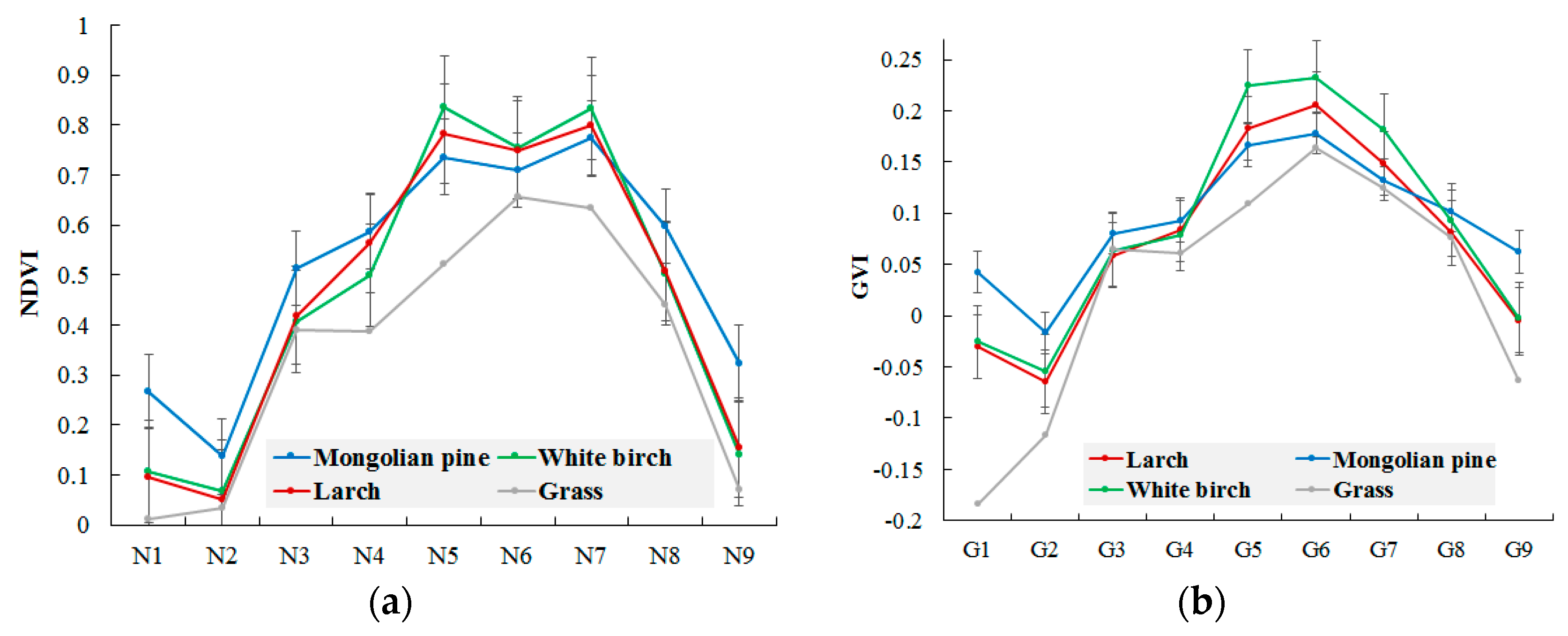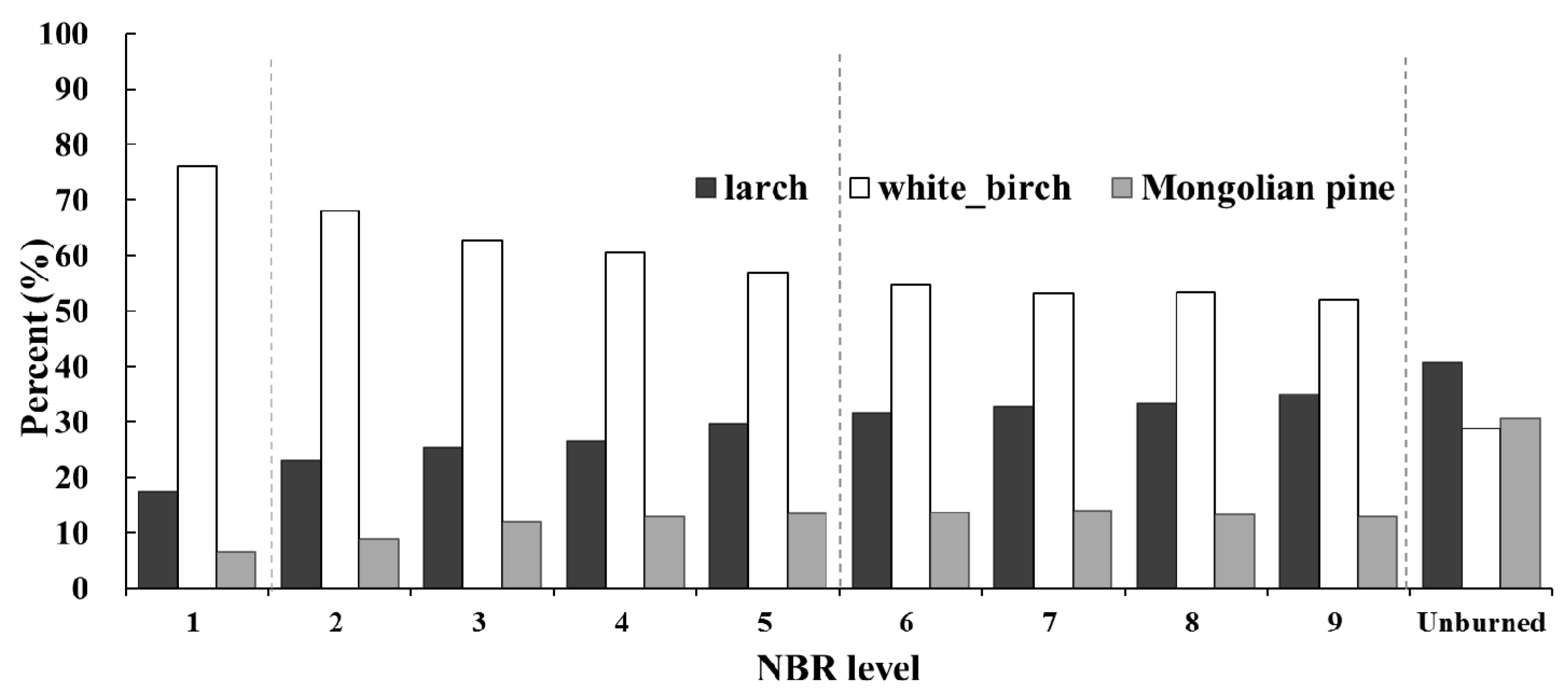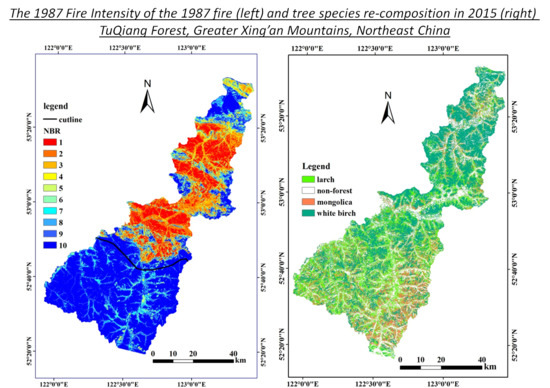Assessing Re-Composition of Xing’an Larch in Boreal Forests after the 1987 Fire, Northeast China
Abstract
:1. Introduction
2. Materials and Methods
2.1. Study Area
2.2. Datasets
2.3. Approaches
2.3.1. Time-Series Spectral Indices
2.3.2. Hierarchical Image Classification
2.3.3. Fire Intensity Mapping and Larch Re-Composition Analysis
3. Results and Discussion
3.1. Tree Species Classification
3.2. The NBR Fire Intensity Map and Xing’an Larch Re-Composition
4. Conclusions
Acknowledgment
Author Contributions
Conflicts of Interest
References
- Gu, Y. The succession of forest communities in the forest region of Greater Xing’anling Mountains. Acta Phytoecol. Geobot. Sin. 1985, 9, 64–70. [Google Scholar]
- Wang, Y.; Zhou, G.; Jiang, Y.; Yang, Z. Estimation Biomass and NPP of Larix Forest Inventory Data (FID). Acta Phytoecol. Sin. 2001, 5, 420–425. [Google Scholar]
- Wang, X.; Li, X.; He, H.; Xie, F. Long-term effect of different planting proportions on forest landscape in Great Xing’an Mountains, Northeast China after the catastrophic fire in 1987. Front. For. China 2007, 2, 382–389. [Google Scholar] [CrossRef]
- Luo, X.; He, H.S.; Liang, Y.; Wang, W.; Wu, Z.; Fraser, J.S. Spatial simulation of the effect of fire and harvest on aboveground tree biomass in boreal forests of Northeast China. Landsc. Ecol. 2014, 29, 1187–1200. [Google Scholar] [CrossRef]
- Wang, X.; Li, X.; He, H.; Hu, Y. Assessing the cumulative effects of postfire management on forest landscape dynamics in northeastern China. Can. J. For. Res. 2006, 36, 1992–2002. [Google Scholar] [CrossRef]
- Sun, L.; Zhang, Y.; Guo, Q.; Hu, H. Carbon Emission and Dynamic of NPP post Forest Fires in 1987 in Daxing’an Mountains. Sci. Silvae Sin. 2009, 45, 100–104. [Google Scholar]
- Yang, S.; Liu, X.; Cao, H. Vegetation change in burned areas in the Greater Hinggan Mountain Forest. J. Northeast For. Univ. 1998, 26, 19–23. [Google Scholar]
- Kong, F.H.; Liu, X.Z. Gradient analysis on the influence of terrain on the forest landscape pattern in the burned blanks of the north slope of Mt. Daxing’anling. Acta Ecol. Sin. 2004, 24, 1863–1870. [Google Scholar]
- Yi, K.; Tani, H.; Zhang, J.; Guo, M.; Wang, X.; Zhong, G. Long-term satellite detection of post-fire vegetation trends in boreal forests of China. Remote Sens. 2013, 5, 6938–6957. [Google Scholar] [CrossRef]
- Goetz, S.J.; Fiske, G.J.; Bunn, A.G. Using satellite time-series data sets to analyze fire disturbance and forest recovery across Canada. Remote Sens. Environ. 2006, 101, 352–365. [Google Scholar]
- Furyaev, V.V.; Vaganov, E.A.; Tchebakova, N.M.; Valendik, E.N. Effects of fire and climate on successions and structural changes in the Siberian Boreal forest. Eurasian J. For. Res. 2001, 2, 1–15. [Google Scholar]
- Zhao, F.J.; Shu, L.F.; Wang, M.Y.; Liu, B.; Yang, L.J. Influencing factors on early vegetation restoration in burned area of Pinus pumila–Larch forest. Acta Ecol. Sin. 2012, 32, 57–61. [Google Scholar] [CrossRef]
- Frolking, S.; Palace, M.; Clark, D.; Chambers, J.; Shugart, H.; Hurtt, G. Forest disturbance and recovery: A general review in the context of spaceborne remote sensing of impacts on aboveground biomass and canopy structure. J. Geophys. Res. 2009, 114, G00E02. [Google Scholar] [CrossRef]
- Chu, T.; Guo, X. Remote sensing techniques in monitoring post-fire effects and patterns of forest recovery in boreal forest regions: A review. Remote Sens. 2014, 6, 470–520. [Google Scholar] [CrossRef]
- Hesketh, M.; Sánchez-Azofeifa, G.A. The effect of seasonal spectral variation on species classification in the Panamanian tropical forest. Remote Sens. Environ. 2012, 118, 73–82. [Google Scholar] [CrossRef]
- Fassnacht, F.E.; Latifi, H.; Stereńczak, K.; Modzelewska, A.; Lefsky, M.; Waser, L.T.; Straub, C.; Ghosh, A. Review of studies on tree species classification from remotely sensed data. Remote Sens. Environ. 2016, 186, 64–87. [Google Scholar] [CrossRef]
- Dymond, C.C.; Mladenoff, D.J.; Radeloff, V.C. Phenological differences in Tasseled Cap indices improve deciduous forest classification. Remote Sens. Environ. 2002, 80, 460–472. [Google Scholar] [CrossRef]
- Liu, W.; Song, C.; Schroeder, T.A.; Cohen, W.B. Predicting forest successional stages using multitemporal Landsat imagery with forest inventory and analysis data. Int. J. Remote Sens. 2008, 29, 3855–3872. [Google Scholar] [CrossRef]
- Cuevas-Gonzalez, M.; Gerard, F.; Balzter, H.; Riaño, D. Analyzing forest recovery after wildfire disturbance in boreal Siberia using remotely sensed vegetation indices. Glob. Chang. Biol. 2009, 15, 561–577. [Google Scholar] [CrossRef]
- Shi, M.; Qi, J.; Yin, R. Has China’s Natural Forest Protection Program Protected Forests?—Heilongjiang’s experience. Forests 2016, 7, 218. [Google Scholar] [CrossRef]
- Li, C.; Wang, J.; Hu, L.; Yu, L.; Clinton, N.; Huang, H.B.; Yang, J.; Gong, P. A Circa 2010 Thirty Meter Resolution Forest Map for China. Int. J. Remote Sens. 2014, 6, 5325–5343. [Google Scholar] [CrossRef]
- Baig, M.H.A.; Zhang, L.; Shuai, T.; Tong, Q. Derivation of a tasseled cap transformation based on Landat 8 at-satellite reflectance. Remote Sens. Lett. 2014, 5, 423–431. [Google Scholar] [CrossRef]
- CART Classification and Regression Trees, SPM 7.0 User Guide, 2012. Available online: https://www.salford-systems.com/products/cart (accessed on 17 May 2017).
- Roy, D.P.; Boschetti, L.; Trigg, S.N. Remote sensing of fire severity: assessing the performance of the Normalized Burn Ratio. IEEE Geosci. Remote Sens. Lett. 2006, 1, 112–116. [Google Scholar] [CrossRef]
- Wang, X.; Wang, W.; Chang, Y.; Fen, Y.; Chen, H.; Hu, Y.; Chi, J. Fire severity of burnt area in Huzhong forest region of Great Xing’an Mountains Northeast China based on normalized burn ratio analysis. Chin. J. Appl. Ecol. 2013, 24, 967–974. [Google Scholar]
- Wang, C.; Fan, Q.; Li, Q.; SooHoo, W.M.; Lu, L. Energy crop mapping with enhanced TM/MODIS time series in the BCAP agricultural lands. ISPRS J. Photogramm. Remote Sens. 2017, 124, 133–143. [Google Scholar] [CrossRef]







| Date | Type | NDVI ID | GVI ID | |
|---|---|---|---|---|
| 1 | 15 June 1987 | Landsat 5 TM | / | / |
| 2 | 20 February 2015 | Landsat 8 OLI | N1 | G1 |
| 3 | 5 March 2014 | Landsat 8 OLI | N2 | G2 |
| 4 | 6 April 2014 | Landsat 8 OLI | N3 | G3 |
| 5 | 11 May 2015 | Landsat 8 OLI | N4 | G4 |
| 6 | 12 June 2015 | Landsat 8 OLI | N5 | G5 |
| 7 | 8 July 2013 | Landsat 8 OLI | N6 | G6 |
| 8 | 31 August 2015 | Landsat 8 OLI | N7 | G7 |
| 9 | 29 September 2014 | Landsat 8 OLI | N8 | G8 |
| 10 | 31 October 2014 | Landsat 8 OLI | N9 | G9 |
| Larch | Mongolian Pine | White Birch | Non-Forest | Samples | User’s (%) | |
|---|---|---|---|---|---|---|
| larch | 24 | 1 | 6 | 4 | 35 | 68.57 |
| Mongolian pine | 5 | 16 | 1 | 0 | 22 | 72.73 |
| white birch | 4 | 0 | 24 | 0 | 28 | 85.71 |
| non-forest | 0 | 0 | 1 | 73 | 74 | 98.65 |
| Samples | 33 | 17 | 32 | 77 | 159 | |
| Producers (%) | 72.73 | 94.12 | 75.00 | 94.81 | ||
| Overall Accuracy: 86.16% | ||||||
| Kappa Coefficient: 0.80 | ||||||
| NBR | Area % | Fire Intensity | |
|---|---|---|---|
| 1 | <−300 | 13.97 | High |
| 2 | [−300, −200] | 8.85 | Medium |
| 3 | [−200, −100] | 4.68 | Medium |
| 4 | [−100, 0] | 3.16 | Medium |
| 5 | [0, 100] | 2.38 | Medium |
| 6 | [100, 200] | 2.25 | Low |
| 7 | [200, 300] | 2.44 | Low |
| 8 | [300, 400] | 3.63 | Low |
| 9 | [400, 500] | 5.30 | Low |
| 10 | >500 | 53.15% | Unburned |
© 2017 by the authors. Licensee MDPI, Basel, Switzerland. This article is an open access article distributed under the terms and conditions of the Creative Commons Attribution (CC BY) license (http://creativecommons.org/licenses/by/4.0/).
Share and Cite
Wang, J.; Wang, C.; Zang, S. Assessing Re-Composition of Xing’an Larch in Boreal Forests after the 1987 Fire, Northeast China. Remote Sens. 2017, 9, 504. https://doi.org/10.3390/rs9050504
Wang J, Wang C, Zang S. Assessing Re-Composition of Xing’an Larch in Boreal Forests after the 1987 Fire, Northeast China. Remote Sensing. 2017; 9(5):504. https://doi.org/10.3390/rs9050504
Chicago/Turabian StyleWang, Junjie, Cuizhen Wang, and Shuying Zang. 2017. "Assessing Re-Composition of Xing’an Larch in Boreal Forests after the 1987 Fire, Northeast China" Remote Sensing 9, no. 5: 504. https://doi.org/10.3390/rs9050504







